
Green is in when it comes to design, especially amongst the younger buying pool, and staircase gardens provide a unique, aesthetically pleasing look for those who want a touch of nature.
Staircases serve an important function both in and out of homes, but their ability to add aesthetic value to a space often goes unrealized. As the desire to bring nature into the home has increased in recent years, homeowners have found a new purpose for these transitional features: staircase gardens. Evoking whimsy, staircases adorned with potted plants or trailing vines add a pop of vibrancy and life to an otherwise overlooked space.
According to Pinterest’s trending searches, interest in staircase gardens is on the rise. Gardening and interest in houseplants, especially by millennials, have both experienced a boom during the pandemic as people have spent more time at home. All that time at home has also allowed people to look at spaces that don’t get used beyond their function, including staircases, but people are bringing them back into the fold using plants. “I think that they may be looking again at their spaces because they’ve been spending more time in their home environments,” says Mary Barensfeld, a Pittsburgh-based architect. “I think there’s something that draws people toward nature, whether that’s going for spending time outdoors or bringing nature into the home and working amongst nature.”
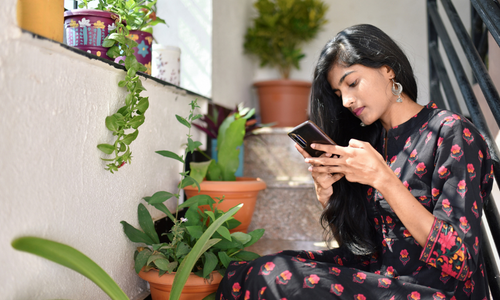
Mayur Kakade / Getty
Adorning staircases with greenery does more than create a cool vibe. It also encourages passersby to momentarily pause and acknowledge the space around them. “Anytime you have a plant somewhere as you walk by, you’re checking on it, right? To see if it needs any water, there’s a new leaf there that you didn’t notice last week,” says Maryah Greene, a plant stylist and founder of Greene Piece. “I love to put plants in any space where mindfulness can be entered into the equation, and stairs are a great place to do that as you move throughout your day,” she says. “It’s just a moment to check in on your space.”
A staircase garden might sound daunting, but can easily be created with just a couple of plants. Here’s what to know if your clients want to add a staircase garden to their homes.
Look Under the Stairs
Sometimes staircases have leftover space underneath that is open but not quite usable for anything else. “It’s a perfect spot to fill with something that doesn’t have the knickknack-y vibe, but it’s a good place to put plants,” says Barensfeld. These spaces receive less natural light, so consider shade-loving plants, like snake plants or maidenhair ferns, and make sure the plants can be easily watered.

Westend61 / Getty
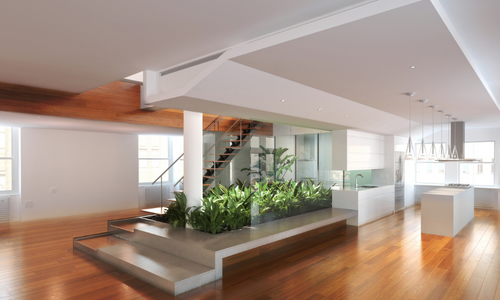
DigitalStorm / Getty
The type and number of plants used under stairs will depend on the size of the space. A single, tall plant might work well for a space that’s small but possesses a decent height. Likewise, in larger spaces, adding more than one plant—or even a mini-atrium of plants—adds a bold statement while still embodying a minimalist look. If the staircase is a focal point in the home, plants help dress it up.
Use a Trailing Plant
Greene advises homeowners to keep stairs as clear as possible—no one wants to trip on a plant. Using a trailing plant to wrap around the railing of the stairs leaves the staircase open while also creating a beautiful space. Picking just a couple of plants that are “super long and vine-y” creates the illusion of “having this lush jungle on your staircase, but it’s only a couple of plants that are just really long,” says Greene.
Plants that typically work best for this include philodendrons, golden pothos and mini monstera (rhaphidophora). To execute this, homeowners should place a plant at the top of the stairs and let it trail down, shaping the plant around the railing. They can also place one plant at the top of the stairs and one at the bottom and have them meet in the middle, which works if the plants are really long.
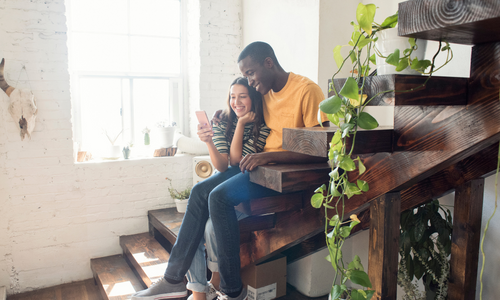
Westend61 / Getty
The best way to encourage length, Greene says, is to find the source of light. “If, on the bottom floor, you have a window, but on the top floor, it’s a bit darker up there, I recommend having that plant in the spot that’s the sunnier so that it can continue to grow, as opposed to having it at the top of the stairs, where there is no sunlight—that plant’s really going to struggle to grow downward,” she says.
Trailing plants work well for outdoor staircase gardens, too. For this locale, planting the vines in soil is key, advises Brandy Hall, founder of Shades of Green Permaculture. “They’re going to be less finicky because they have contact with the soil,” says Hall. “They’re going to get water, and they’re going to get nutrients. You don’t have to really think about them as much as you do with containers.” Plants like creeping figs are great to train against closed risers, while muscadines and evergreen clematis can work great with railings, depending on the conditions.
Keep Pot Size in Mind
As tempting as it may be for homeowners to arrange potted plants on their staircases, it’s important to remember to keep the steps as clear as possible. It can be done, though, if pot size is taken into consideration.
When plants come home from the plant shop, they should ideally be repotted into a container that’s an inch or two bigger than the nursery pot, says Greene. A pothos in a four-inch pot at the nursery, for example, should go into a six-inch pot at home. “You want to figure out the diameter of your steps and make sure that pot isn’t taking up way too much space on your stairs to prevent you from using those stairs,” says Greene. “Start smaller than you think, because plants grow, of course, and so as that plant continues to grow, you’re eventually going to pot it into something bigger every couple of years.”
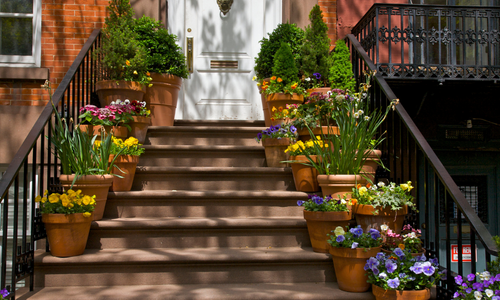
Barry Winiker / Getty
Another cool way to use potted plants is to consider the WallyGrow planter system, which allows users to create plant walls with various hanging planters. “Their main focus is allowing you to create a living wall, or a live plant hanging anywhere in your home. I’d definitely recommend those; they’re awesome, they make watering easy. If you have hardwood floors, you’re not ruining those,” says Greene. They can be arranged on the wall along a staircase, leaving the railings and stairs clear.
Get Colorful
While green houseplants work well for indoor staircases—and some do have flowers or colorful leaves—outside staircases are great spaces to introduce pops of color. Homeowners can carefully arrange potted annual flowers to create a lively space. “I really love using bunching grasses in outdoor containers, because they have a lot of seasonal interest and they overwinter really well, even though they don’t stay green year-round,” says Hall.
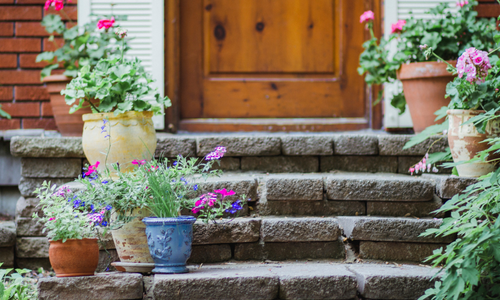
Bunching grasses like chasmanthium and river oats are especially great for this purpose. “They have really beautiful seed heads in the fall, and then they’ll stay golden during the winter and then come back to life in the spring,” says Hall.
With younger home buyers trending green and showing an uptick in interest in houseplants and gardening, staircase gardens are a great and relatively easy way to meet demand and bring the outdoors in or simply to dress up an underutilized space. They’re also a great tool for staging or helping your client set up their space once they’ve purchased a home.
 Lia Picard – Lia Picard is a lifestyle journalist based in Atlanta. Interior design is one of her main beats, including the spaces themselves and the people and trends of note in the industry. Her work appears in the New York Times, the Wall Street Journal, the Washington Post, and other national and regional outlets. Follow Lia and her work on Instagram @LiaPicard.
Lia Picard – Lia Picard is a lifestyle journalist based in Atlanta. Interior design is one of her main beats, including the spaces themselves and the people and trends of note in the industry. Her work appears in the New York Times, the Wall Street Journal, the Washington Post, and other national and regional outlets. Follow Lia and her work on Instagram @LiaPicard.
No comments:
Post a Comment